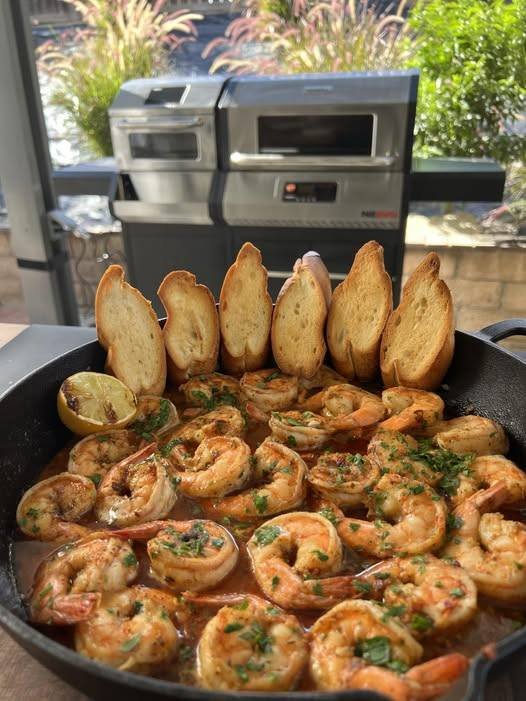Few dishes capture the essence of coastal Italian-American cuisine as beautifully as shrimp scampi. This elegant yet approachable dish brings together plump shrimp sautéed in a fragrant bath of butter, garlic, white wine, and lemon. It’s one of those recipes that feels indulgent but is surprisingly easy to prepare, making it a favorite for weeknight dinners, family gatherings, or even a romantic evening at home. With its silky sauce and bright flavors, shrimp scampi can be served over pasta, with crusty bread, or even on its own as a light entrée. Let’s dive into the origins, ingredients, step-by-step method, and a few variations to make this timeless dish your own.
The Origins of Shrimp Scampi
Traditionally, “scampi” refers to a type of small European lobster known as langoustine. Italian immigrants in America often substituted large shrimp for scampi, pairing them with classic Mediterranean flavors like garlic, olive oil, and lemon. Over time, this evolved into the dish we know today: shrimp scampi. While the name may seem redundant—essentially “shrimp shrimp”—it perfectly captures the melding of Italian roots with American seafood traditions.
Ingredients You’ll Need
To prepare shrimp scampi, you don’t need an overwhelming list of ingredients. What makes the dish remarkable is the balance of simple, fresh elements that come together to create bold, irresistible flavors.
-
1 pound large shrimp (peeled and deveined, tails on for presentation if desired)
-
3 tablespoons unsalted butter
-
2 tablespoons olive oil
-
4 garlic cloves, finely minced
-
½ cup dry white wine (such as Sauvignon Blanc or Pinot Grigio)
-
1 lemon (juice and zest)
-
¼ teaspoon crushed red pepper flakes (optional, for a touch of heat)
-
Salt and freshly ground black pepper (to taste)
-
2 tablespoons fresh parsley, chopped
-
8 ounces linguine or spaghetti (optional, if serving with pasta)
-
Freshly grated Parmesan cheese (optional garnish)
Step-by-Step Preparation
Step 1: Prepare the Shrimp
If you’re starting with frozen shrimp, thaw them thoroughly and pat them dry with paper towels. This step is crucial to ensure the shrimp sear properly rather than steam in the pan. Lightly season them with salt and pepper.
Step 2: Cook the Pasta (if using)
Bring a large pot of salted water to a boil and cook your pasta until al dente, usually 1–2 minutes less than the package directions. Reserve about ½ cup of the starchy pasta water, then drain and set the pasta aside. This water can help emulsify the sauce later.
Step 3: Sauté the Shrimp
Heat a large skillet over medium-high heat. Add one tablespoon of olive oil and one tablespoon of butter. Once the butter melts and begins to foam, add the shrimp in a single layer. Cook for 1–2 minutes per side until they turn pink and opaque. Be careful not to overcook them; shrimp cook quickly and can become rubbery. Remove the shrimp from the skillet and set aside.
Step 4: Make the Sauce
Reduce the heat to medium. Add the remaining olive oil and butter to the skillet. Stir in the minced garlic and sauté for about 30 seconds until fragrant, being careful not to burn it. Pour in the white wine and let it simmer for 2–3 minutes, reducing slightly to intensify the flavor. Add the lemon juice, zest, and a pinch of red pepper flakes for a gentle kick.
Step 5: Combine Shrimp and Pasta
Return the shrimp to the skillet, tossing gently to coat them in the sauce. If you’re serving with pasta, add the drained pasta directly into the pan, tossing everything together. If the mixture looks dry, add a splash of the reserved pasta water to create a glossy, cohesive sauce.
Step 6: Garnish and Serve
Sprinkle in the fresh parsley just before serving for a burst of color and freshness. Serve the shrimp scampi immediately, with extra lemon wedges on the side and a light dusting of Parmesan if desired. A loaf of warm, crusty bread makes an excellent accompaniment to soak up the buttery sauce.
Serving Suggestions
Shrimp scampi is incredibly versatile. Over pasta, it becomes a satisfying main course. Paired with rice or couscous, it takes on a lighter Mediterranean flair. For a low-carb option, serve it over zucchini noodles or spaghetti squash. You can even skip the starch entirely and enjoy it with a crisp green salad and some roasted vegetables. A chilled glass of white wine, ideally the same variety used in the sauce, pairs perfectly with the dish.
Tips for Perfect Shrimp Scampi
-
Use fresh shrimp if possible. Fresh, high-quality shrimp elevate the dish. If using frozen, thaw gently in the refrigerator.
-
Don’t overcook the shrimp. They only need a couple of minutes per side. Remove them promptly once pink and opaque.
-
Balance the flavors. The butter provides richness, the lemon adds brightness, the wine lends depth, and the garlic infuses warmth. Adjust proportions to suit your taste.
-
Emulsify the sauce. A splash of starchy pasta water can help the butter and wine meld into a silky sauce that clings to pasta beautifully.
Variations to Try
-
Creamy Shrimp Scampi: Add a splash of heavy cream at the end for a richer, more decadent sauce.
-
Spicy Shrimp Scampi: Increase the red pepper flakes or add a diced chili pepper for extra heat.
-
Herbed Shrimp Scampi: Experiment with fresh basil, thyme, or oregano for unique flavor profiles.
-
Lemon-Garlic Rice: Instead of pasta, serve the shrimp and sauce over fluffy rice flavored with lemon zest and herbs.
Conclusion
Shrimp scampi is proof that simple ingredients can produce extraordinary results. With its balance of buttery richness, bright citrus, and savory garlic, it delights both the cook and the diner. Whether you prepare it for a quick weeknight dinner or a special occasion, shrimp scampi never fails to impress. It’s a dish that embodies both comfort and elegance—one that you’ll find yourself coming back to time and time again.
